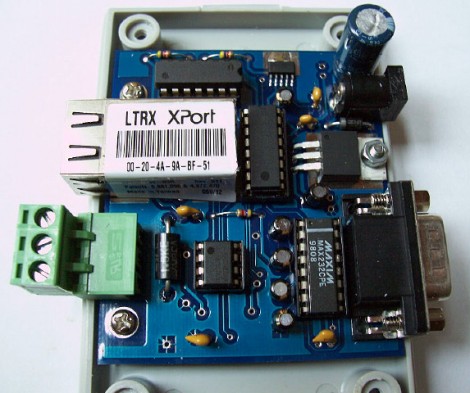
Here’s a serial to Ethernet module that you won’t have to write firmware to build. It uses a Lantronix XPORT module which takes care of all the work for you, including an embedded webserver. Both RS232 and RS485 data buses are connected to the XPORT serial input via a level converter to step the signal down to 3.3V. This solution comes at a price because of the ethernet module, but it would make a nice prototyping tool for testing projects that work on the two serial protocols.















Nice!
It reminds me of some of the proprietary communications adapters I’ve seen used in the industrial process controls sphere, only without the proprietary. ;)
I used one of these in my robotics creation in 2004, and the price hasn’t gone down a single cent. I guess they are ripe for a bit of healthy competition.
They have a wireless equivalent: the Wiport, which can triple most of our hobby BOM costs.
Looks like the XPort alone is USD$50. Considering the limited functionality needed for most embedded ethernet devices (raw sockets, web pings anybody?) it might be a pain to deal with the ENC28J60 but at $40 less per unit I’ll keep doing it.
And what the hell would you use one of these for?
I think anything that says “takes care of all the work for you” should probably not be featured on HAD.
In my day, we didn’t just reinvent the wheel for every project. We reinvented hubs and axles too, god dammit!
I wish they would have made it in an arduino shield form factor :-(
Would this be suitable for using a serial terminal as a telnet terminal over ethernet?
Arduino clone + ethernet shield = a shit ton cheaper than this
@cantdio Yes, but this goes straight to a standard serial port.
@Paul Potter
Ok, arduino clone + ethernet shield + max232 board off ebay.
There are cheaper ways of doing the same thing the Xport does, but none as small or simple to connect to. I am not sure why they did not use the Xport which has 5V tolerant IO, or just use 232 and 485 drivers that are 3.3V compatible, it would have saved a lot of level translation. This type of device can be very useful on the work bench.
fairly sure DigiConnect does something similar to this.
Having spent the past few weeks working with XPorts for work here are some things to keep in mind about the lowest/cheapest module (I.e. These notes don’t apply to the XPort AR or XPort Pro):
– It has 5V tolerant pins.
– The built-in web server can only serve static data.
– It’s extremely expensive compared to other ethernet modules but it is considerably smaller and fully self-contained.
– It can only handle a single connection at a time on the single forwarded port. If you’re running a webserver on an AVR/PIC behind the XPort for example (For being able to serve dynamic data) there is no way for you to identify unique connections. This means if the user rapidly presses the refresh button in their browser or if they disconnect and someone else connects immediately they will get the wrong data from the device.
Overall the XPort is only suited for simple projects that communicate over RS232/RS485 (Exactly what the XPort is advertised as). If you want to network-enable a serious embedded device consider the XPort Pro (Embedded Linux OS) for small runs or a dedicated ethernet controller IC/microcontroller for larger ones.
http://cgi.ebay.ca/ENC28J60-V2-0-SPI-Interface-Ethernet-Module-MCU-ARM-/190423978325?pt=LH_DefaultDomain_0#ht_1965wt_1137
Franklyn or anyone else really, serious question: Why would someone use something like that instead of something like this:
http://www.wiznet.co.kr/Sub_Modules/en/product/Product_Detail.asp?cate1=6&cate2=13&cate3=0&pid=1092#tab
It’s the WIZ107SR. It’s only a few $ more and has the TCP/IP stack integrated. Seems like a much simpler and neater solution? The only gripe I have with it is the RS232 interface – would have preferred USART.
Awesome. My work uses lantronix Xport modules for access control modules.
Might just build one for the sake of it.
“… that you won’t have to write firmware to build”
“… takes care of all the work for you”
i’ll take this as an insult. :)
@ Franklyn – I have used both the Lantronix and the Han Run products and, believe me when I say you WANT to stay with Lantronix. The Han Run modules are very unreliable. The Lantronix units are great as long as you make sure your power is steady enough that you don’t drop below 2.6V.
Little known fact:
Many university vending machines / laundry networks run off RS485 over ethernet cabling. Oh the possibilities since Bl/\ckBoard does not do a thing to ensure security!
this is great module.. Thanks for sharing..